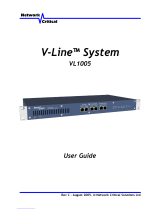
Item Description
10 10/100/1000 Management port
11 Back panel LEDs (3)
1
Power Supply A. Power supply A is included with each Sensor. The supply uses a standard IEC
port (IEC320-C13). McAfee provides a standard, 2m NEMA 5-15P (US) power cable (3 wire).
International customers must procure a country-appropriate power cable.
2
Power Supply B (optional, purchased separately). Power supply B is a hot-swappable, redundant
power supply. This power supply also uses a standard IEC320-C13 port, and you can use
McAfee-provided cable or acquire one that meets your specific needs.
3
One RS-232C Console port, which is used to set up and configure the Sensor.
4
One RS-232C Auxiliary port, which may be used to dial in remotely to set up and configure the
Sensor.
5
Six RJ-11 Fail-Open Control ports, designed for use with the Optical Fail-Open Bypass kit. The
ports are marked X1, X2, X3, X4, X5, X6, (1A-1B to 6A-6B respectively.)
6
Eight small form-factor pluggable (SFP) 1 Gigabit Monitoring ports, which enable you to
monitor eight SPAN ports, four full-duplex tapped segments, four segments in-line, or a
combination (that is, for example, two full-duplex segment and four SPAN ports).
7
Four 10 Gigabit small form-factor pluggable (XFP) 10 Gigabit Monitoring ports, which
enable you to monitor four SPAN ports, two full-duplex tapped segments, two segments in-line, or
a combination (that is, for example, one full-duplex segment and two SPAN ports).
The Monitoring interfaces of the M-3050/M-4050 work in stealth mode, meaning they have no IP
address and are not visible on the monitored segment.
If you choose to run in failover mode, port 2A is used to interconnect with a standby Sensor.
The gigabit ports of the M-3050/M-4050 when deployed in in-line, fail-close, meaning that if the
Sensor fails, it will interrupt/block data flow. Fail-open functionality requires either the Layer 2
Passthru feature or the hardware Gigabit Fail-Open Bypass kit for Gigabit ports. The Layer 2
Passthru feature is described in detail in the McAfee Network Security Platform Device
Administration Guide.
8
One External Compact Flash port. This port is used only for flash recovery purposes. That is,
this port is used in troubleshooting situations where the Sensor's internal flash is corrupted and
you need to reboot the Sensor through the external compact flash. For more information, see the
on-line KnowledgeBase at http://mysupport.mcafee.com/Eservice/. Click Search the KnowledgeBase.
9
One RJ-45 Response port, which, when you're operating in SPAN or tap mode, enables you to
inject response packets back through a switch or router.
10
One RJ-45 10/100/1000 Management port, which is used for communication with the
Manager server. You can assign an IP address to this port during installation.
The M-3050/M-4050 does not have internal taps; you must use it with a third-party external tap to
run it in tap mode.
Front and back panel LEDs
The front panel LEDs provide status information for the health of the Sensor and the activity on its
ports. The following table describes the M-3050/M-4050 front panel LEDs.
Overview
M-3050/M-4050 physical description
1
McAfee
®
Network Security Platform M-3050/M-4050 Sensor Product Guide
11





















